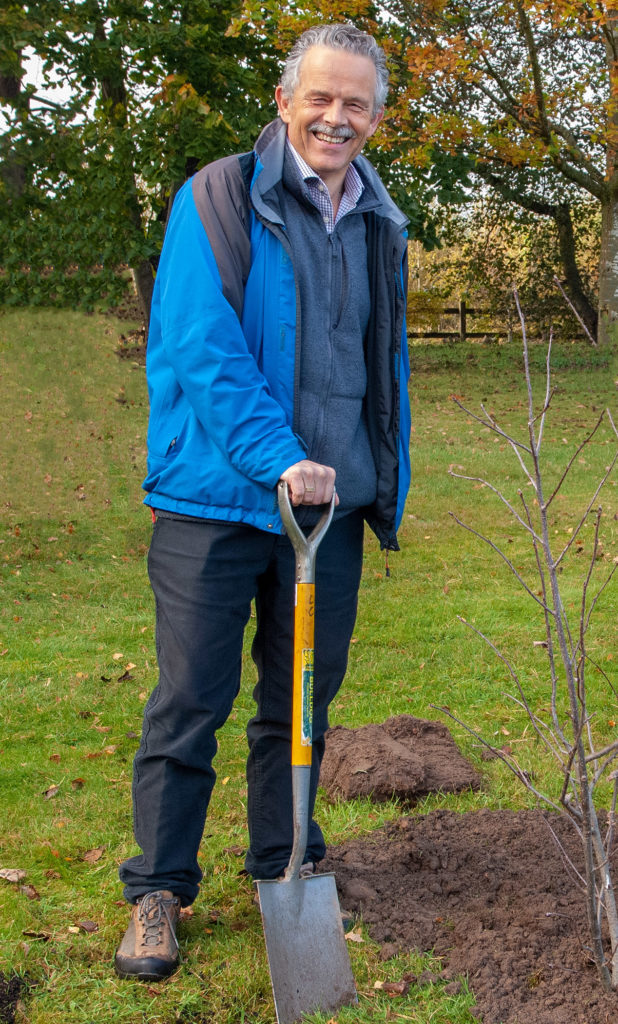Research supporting the health of UK forests and biodiversity.
Professor Chris Quine is Chief Scientist of Forest Research, the research agency of the Forestry Commission and the UK’s principal organisation for forestry- and tree-related research. Currently based at their Northern Research Station just outside Edinburgh. He has worked for over 35 years in sustainable forest management, initially as a forest manager and mainly in applied research involving knowledge exchange with policymakers and practitioners.
Today, Chris oversees a diverse portfolio of research programmes including those focused on forest biodiversity and ecosystem services, forest management and tree health, climate change mitigation and adaptation and explorations of the interface between ecological and social studies of trees, woods and forests.
“Research was for me”
Chris took a first degree in Geography at Cambridge University. An Honours project awakened an interest in trees – and shaped a general wish to work on environmental matters into a focus on the conservation, stewardship and management of trees and forests. “That first project,” he recalls, “Was sparked by an interest in island biogeography (with a dose of realism and focus provided by the great palaeoecologist Professor H.J.B. Birks), and investigated whether the pine trees of the islands in Loch Assynt, northwest Scotland, were native, a question which had been unresolved in the classic monograph The Native Pinewoods of Scotland (by H.M. Steven and A. Carlisle).”
Chris consolidated this interest – and, as he puts it, “at the same time made himself employable,” – by taking an MSc in Forestry and its Relation to Land Use at Oxford University. He joined the Forestry Commission as an Assistant District Manager in Galloway, where his early duties included forest design on the shores of Loch Ken and further expansion of Glentrool Forest. “At that time,” says Chris, “the Forestry Commission offered opportunities to undertake specialist tours to broaden experience, and I successfully applied for a position as silviculturist at the Northern Research Station.” Here his responsibilities included developing techniques of site preparation for tree planting, and studying the effects of strong winds on trees.
“Deciding that research was for me,” Chris says, “I applied to stay in Forest Research rather than return to regional posts, and undertook a part-time PhD at the University of Edinburgh.” Here, he studied the role of wind as a disturbance agent in upland forests, helping develop ForestGALES, a computer-based decision-support tool enabling forest managers to estimate the probability of wind damage to any conifer stand in Britain.
Wide-ranging and cross-disciplinary
Since then, Chris’s research interests have encompassed forest biodiversity, risk management, scenario planning, landscape and woodland ecology – including contributing to the EU LIFE project Urgent Conservation Management for Scottish Capercaillie, and initiating several PhDs on the ecology of capercaillie and pine marten in managed forests.
Most recently, Chris has been involved in cross-cutting interdisciplinary research including as an expert panel member and co-ordinating lead author for the Woodlands chapter of the UK National Ecosystem Assessment; studies of risk communication around Lyme disease; and several projects addressing the threats posed by pests and diseases to our woods and forests. He is sector lead for forestry at Scotland’s Centre of Expertise for Plant Health, and works with other members of Scotland’s Environment and Forestry Directorate to encourage cross-sectoral solutions to mitigate risks to plant health and the natural environment, including publishing a set of key principles to encourage biosecurity and secure the health of Scotland’s plants.

As Chief Scientist since 2018, Chris says he enjoys, “a broad overview of wide-ranging research programmes, contributing to development of strategies for applied research, and encouraging collaborative research with many organisations across Scotland and further afield.” Many of these activities seek to provide an evidence-base for policy to support woodland expansion (in many forms) to address the climate and biodiversity crises, including the need to reconcile multiple objectives and the impacts of resource consumption in the UK with overseas. “Research,” Chris emphasizes, “must also underpin the evolution of sustainable forest management to encourage climate change adaptation, improve habitat quality, and counter abiotic and biotic threats.” A crucial role, in these challenging times for our environment.
Professor Chris Quine is Chief Scientist of Forest Research. He holds an Honorary Professorship at the University of Stirling in recognition of his productive links with the School of Biological and Environmental Sciences, and is a Fellow of the Institute of Chartered Foresters. His work is supported by the Scottish Government. Find out more here.
This post is part of a series showcasing Scotland’s innovative, high-impact research supporting biodiversity conservation, in partnership with Scottish Government and NatureScot. Read the rest of the series here.
Further reading
Quine, C.P., Gardiner, B.A., & Moore, J. 2021. Wind disturbance in forests: The process of wind created gaps, tree overturning and stem breakage. Pp. 117—184 in Johnson, E.A. & Miyanishi, K. (eds.) Plant Disturbance Ecology: the Process and the Response. 2nd Edition, New York: Academic Press (Elsevier).
Quine, C.P. 2019. Forest Hazards. Pp. 159—182 in Gambles, I. (ed.) British Forests. London: Profile Editions.
Broome, A., et al. 2019. Niches for Species, a multi-species model to guide woodland management: An example based on Scotland’s native woodlands. Ecological Indicators 103: 410—424. https://doi.org/10.1016/j.ecolind.2019.04.021
Young, J.C., et al. 2018. Working with decision-makers for resilient forests: A case study from the UK. Forest Ecology and Management 417: 291—300. https://doi.org/10.1016/j.foreco.2017.12.042
